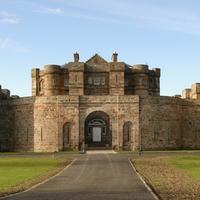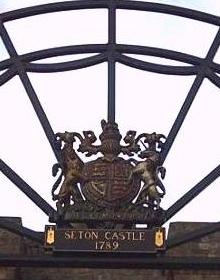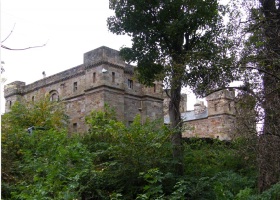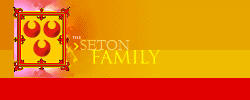 THE MIRACLE makeover is a staple of daytime television. Take a
piece of mutton dressed as trout, give her some new lipstick and
a little black dress and she’s suddenly turning heads like Kate
Winslet. It works for property, too. Give your rundown semi a
new kitchen and a lick of paint and watch those offers flood in.
But did you hear about the former bankrupt who added £13.75
million to the value of her house in two years? All she had to
do was use the same interior decorator as the Queen.
THE MIRACLE makeover is a staple of daytime television. Take a
piece of mutton dressed as trout, give her some new lipstick and
a little black dress and she’s suddenly turning heads like Kate
Winslet. It works for property, too. Give your rundown semi a
new kitchen and a lick of paint and watch those offers flood in.
But did you hear about the former bankrupt who added £13.75
million to the value of her house in two years? All she had to
do was use the same interior decorator as the Queen.
Seton Castle, near Longniddry in East Lothian,
was profiled in these pages more than two years ago when it was
being sold by the Earl of Wemyss for offers above £750,000. The
Robert Adam property, set in 13½ acres, was built in 1791 and
for much of its history had been tenanted. As a result it was in
quite a dilapidated state when Mary McMillan bought it for £1.25
million in December 2002.
The mother of six came from a working-class
mining background and left school at 16. She says she made money
in buying and selling furniture and later married a property
developer. However, she was declared bankrupt in 1999 after
owing money to a bank and came out of bankruptcy only two months
before buying Seton Castle. Part of the money came from the sale
of her home in Brunstane, near Edinburgh, which rose in value
from £130,000 to more than £1 million over 13 years. That was
just an appetiser for Mrs McMillan’s next money-spinner —
turning Seton Castle from an ugly duckling into a possible £15
million swan.
 Seton Castle is an exquisite example of Adam’s
fascination with castle designs, but it had fallen into
disrepair and experts had placed the cost of restoration at well
in excess of £1 million. If you’re going to spend that sort of
money, you may as well get the best. Enter Malcolm Duffin. The
former head of design at the 200-year-old company Whytock & Reid
had created fabric and furnishings for pop stars and the Royal
Family — check out what he has done with the downstairs loo at
Buckingham Palace next time you are there — and was now in
charge of design at the Edinburgh firm Zebrano. He leapt at the
opportunity to restore the castle to its former glory.
Seton Castle is an exquisite example of Adam’s
fascination with castle designs, but it had fallen into
disrepair and experts had placed the cost of restoration at well
in excess of £1 million. If you’re going to spend that sort of
money, you may as well get the best. Enter Malcolm Duffin. The
former head of design at the 200-year-old company Whytock & Reid
had created fabric and furnishings for pop stars and the Royal
Family — check out what he has done with the downstairs loo at
Buckingham Palace next time you are there — and was now in
charge of design at the Edinburgh firm Zebrano. He leapt at the
opportunity to restore the castle to its former glory.
“A Robert Adam house sets an immediate tone for
the scale of the project,” he says. “The highest priority was
not to reinvent the wheel but to come up with a design that gave
respect to the original architect.” That meant late nights of
research and intense study of the Robert Adam archive,
rediscovering the dazzling colours and delicate ornaments that
Adam liked to employ.
“The design was quite easy,” he says. “We simply
stripped the place back to its bare walls and rebuilt, replumbed,
rewired it all. Put in central heating, a new kitchen, restored
the stonework and designed and rebuilt the extensive parkland.”
Easy for him, perhaps.
The first task was the landscaping and the
creation of a structured parterre garden in the overgrown
courtyard. Duffin prepared a design, which was completed by
David Domoney, a landscape gardener. Inside, the main staircase
was fully restored, with ironwork based on an original Robert
Adam design and a scarlet and gold carpet. The hall walls were
painted in a red so deep that it required six coats; a pair of
newly upholstered Louis XV chairs added to the effect.
While most DIY stores will mix you a paint that
goes with the new sofa, Duffin took this idea to its apotheosis
with a silk damask for the dining room inspired by the colour of
an emerald belonging to the owner. Adam-style curtains were
added, as well as 18th-century chandeliers.
So far, so plush. Duffin then marched on with an
oriental pale-blue silk wallpaper for the 440 sq ft master
bedroom, a low-ceilinged study at the top of the house inspired
by the mid-20th-century French designer Pierre Frey and a
trompe-l’oeil panelled dining room with baby grand piano.
 It is the transformation of the dank and dingy
basement that is perhaps Duffin’s greatest achievement with the
house. The spacious new kitchen has two Agas and a game storage
room hung with paintings of wild animals, while another room
that was filled with rubble and water has been transformed into
a dark oak-panelled billiard room. A children’s playroom has
also been added.
It is the transformation of the dank and dingy
basement that is perhaps Duffin’s greatest achievement with the
house. The spacious new kitchen has two Agas and a game storage
room hung with paintings of wild animals, while another room
that was filled with rubble and water has been transformed into
a dark oak-panelled billiard room. A children’s playroom has
also been added.
The restoration project has taken 18 months —
about the time that it took Adam to build the house in the first
place — and it is not complete. The wings of the castle need
work and there is a jail to do up too. Duffin understandably
refuses to comment on how much was spent, although Mrs McMillan
has said that many friends offered their time free. Nonetheless,
such opulent fittings cannot have come cheap and estimates in
the local press have claimed that £2 million or more would have
had to be spent on bringing it up to such a high standard.
But how has the property come on to the market at
such an inflated price of £15 million? The new castle has been
transformed spectacularly, but a mark-up of £13.75 million has
raised eyebrows, particularly as the record for a house sale in
Scotland was £7 million for Lee Castle, near Lanark, last year.
The answer might lie in the choice of agents.
Seton Castle is being marketed by Coldwell Banker, an American
firm, and it is difficult to avoid the suspicion that the owner
might be testing the water to see what exceptionally wealthy
international buyers are happy to pay before risking the more
discerning domestic market. Hollywood stars, wealthy American
bankers or even Russians are the likely target.
“You mustn’t underestimate the value of history,”
says Audree Mevellec, the selling agent. “We don’t have this
sort of place in America. I’ve sold small houses in Texas for
£10 million, so Seton Castle is something of a bargain.”
Of course, a place is worth only what someone is
prepared to pay for it, and if Mrs McMillan can find someone to
pay £15 million for Seton Castle, then good luck to her. At
least the new owner will not have to worry about doing up the
place for some time.


